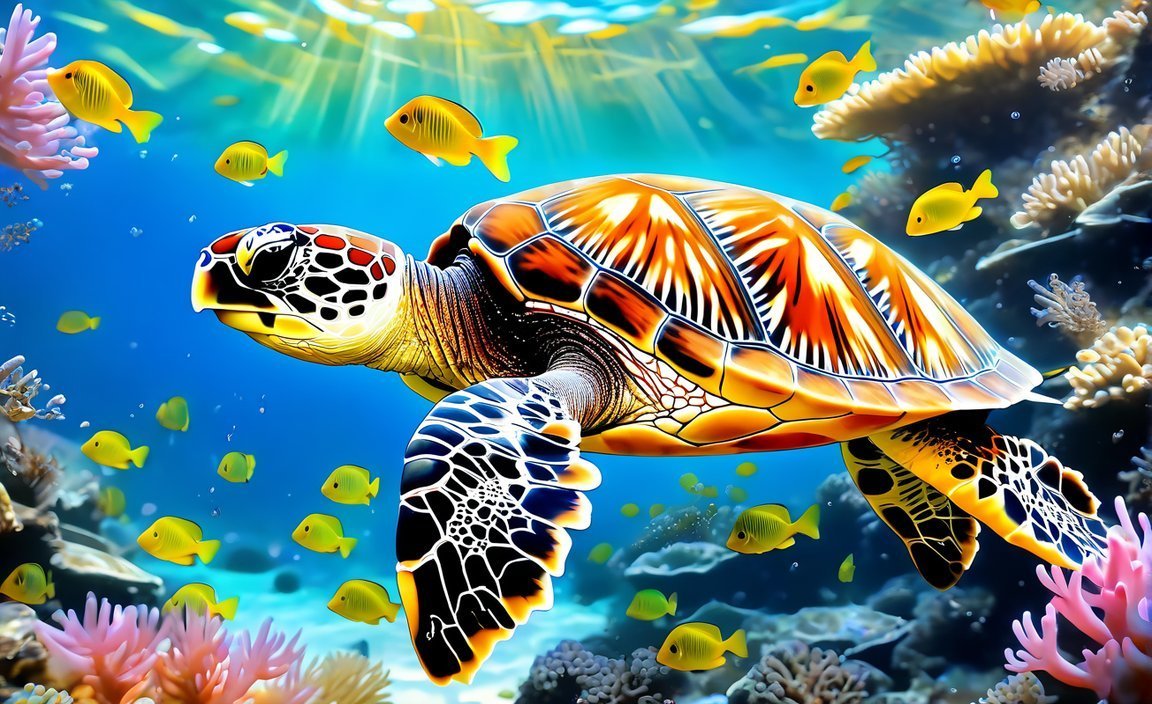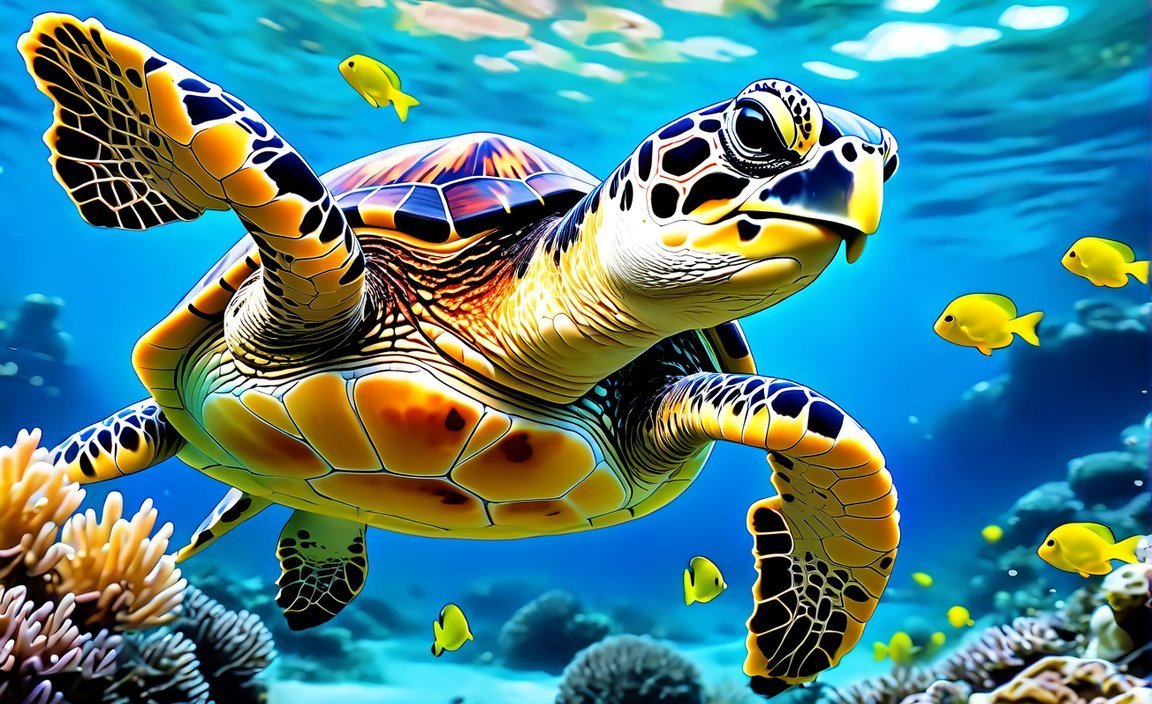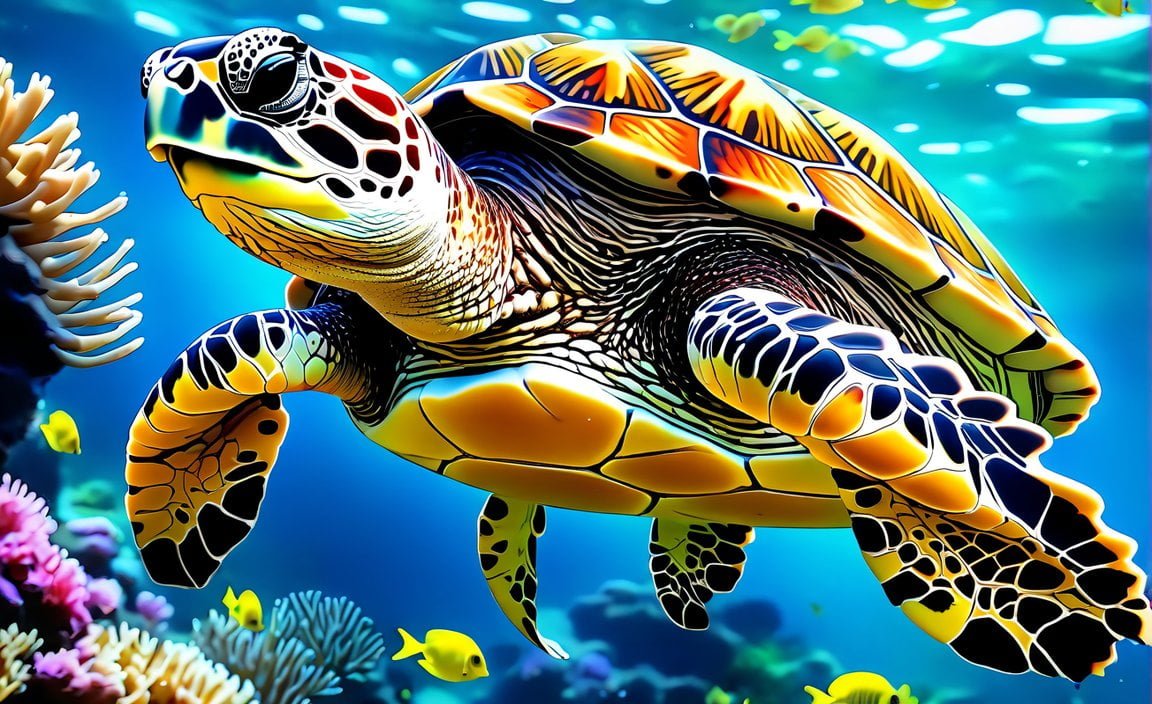If you’re a nature enthusiast or have a passion for marine conservation, you’re in for a treat! In this article, we will delve into the intriguing world of hawksbill sea turtles and uncover 10 fascinating facts about these remarkable creatures. As we explore their unique behaviors, habitats, and conservation status, you’ll gain a deeper understanding of why protecting them and their delicate ecosystems is of utmost importance. So, let’s dive in and discover 10 fascinating facts about hawksbill sea turtles!

Key Takeaways:
- Hawksbill sea turtles have pointed beaks and beautiful colors.
- The largest colony in the world nests on Milman Island in Queensland, Australia.
- Hawksbill sea turtles have been swimming in the oceans for much longer than humans have been on Earth.
- They are named after their sharp, curving beak that resembles a hawk’s bill.
- They are excellent swimmers and can reach speeds of up to 20 miles per hour.
- Their diet consists of sea grasses, small invertebrates, and algae, with sponges being their primary food source.
- Hawksbill sea turtles are found in tropical and subtropical waters around the world.
- Their shells have a distinctive serrated look on the edges due to overlapping scales.
- The shells of hawksbill sea turtles are highly valued and commonly sold as “tortoiseshell” in markets.
- Hawksbill sea turtles play a vital role in maintaining the health and diversity of coral reefs.
10 Interesting Facts About Hawksbill Sea Turtles
Hawksbill sea turtles are captivating creatures that inhabit tropical and subtropical waters around the world. These magnificent marine animals possess remarkable characteristics that make them a subject of intrigue and importance. Here, we delve into 10 intriguing facts about hawksbill sea turtles that shed light on their unique biology and significance for marine conservation.
1. Hawksbill Sea Turtles: The Ocean’s Artists
With their distinctive pointed beaks and stunningly beautiful colors, hawksbill sea turtles are often hailed as nature’s artists. Their shells display a mosaic-like appearance, combining shades of brown, orange, and yellow. This striking pattern resembles an artist’s brushstrokes, making these sea turtles a sight to behold.
2. The Largest Colony on Milman Island
In Queensland, Australia, lies Milman Island – home to the largest colony of hawksbill sea turtles in the world. This remarkable nesting site serves as a testament to the importance of preserving their natural habitats and protecting their fragile ecosystems.
3. Ancient Swimmers
Hawksbill sea turtles have been swimming in the oceans for a far longer time than humans have existed on Earth. With a history spanning millions of years, these awe-inspiring creatures have witnessed the ever-changing landscape of our planet’s waters.
4. A Beak Like No Other
The hawksbill sea turtle owes its name to its sharp, curving beak that closely resembles a hawk’s bill. This unique feature enables them to reach into crevices and cracks in reefs, extracting their main diet of sponges with ease.
5. Masters of the Sea
These incredible swimmers can propel themselves through the water at impressive speeds of up to 20 miles per hour. With their streamlined bodies and powerful flippers, hawksbill sea turtles gracefully glide across the ocean depths.
6. A Varied Diet
While their primary diet consists of sponges, hawksbill sea turtles also consume a variety of other marine delicacies. They feed on sea grasses, small invertebrates, and algae, showcasing their adaptability and versatility.
7. Global Wanderers
Hawksbill sea turtles are found in tropical and subtropical waters all around the globe. They inhabit the Atlantic, Pacific, and Indian Oceans, each population contributing to the intricate tapestry of marine life.
8. Serrated Shells
One of their most distinctive features is the shell, which boasts a remarkable pattern of overlapping scales. These scales give the shell a serrated appearance, adding another layer of aesthetic allure to these magnificent creatures.
9. The Price of Beauty
Sadly, hawksbill sea turtles have fallen prey to the allure of their own beauty. The intricate patterns on their shells, known as “tortoiseshell,” have made them targets for poaching. Their shells are highly valued and commonly sold in markets, exacerbating the threats they already face.
10. Guardians of Coral Reefs
Hawksbill sea turtles play a crucial role in maintaining the health and diversity of coral reefs. As they feed on sponges and algae, they prevent these organisms from overpowering the reefs and maintain a delicate balance within these vital ecosystems.
From their exquisite appearance to their important ecological contributions, hawksbill sea turtles continue to fascinate and play a significant role in our planet’s delicate marine ecosystems. Understanding these intriguing facts brings us closer to appreciating their unique beauty and the urgent need to protect their endangered status, ensuring future generations can experience the wonders of these magnificent creatures.
Sources:
– Hawksbill Sea Turtle Fact & Information
– Fun Facts About Hawksbill Sea Turtles
Here are some captivating facts about hawksbill sea turtles! Did you know that they can live up to 50 years? Discover more fun facts about hawksbill sea turtles here.
Curious about the human foods that are safe for dogs to eat? Check out this list of 10 human foods dogs can eat here and ensure your furry friend stays healthy and satisfied!
Looking for ways to treat your dog while being mindful of their health? Explore this fascinating list of 10 human foods that are good for dogs here and discover nutritious options for your four-legged companion.
Learn some intriguing facts about alligator snapping turtles. Did you know they have one of the strongest bites in the animal kingdom? Find out more fascinating information about alligator snapping turtles here.
Ever wondered what it’s like to be a veterinarian? Uncover 10 interesting facts about being a veterinarian here and gain insight into this rewarding profession.
Falcons are incredible birds known for their speed and agility. Discover 10 captivating facts about falcons here and learn more about these majestic creatures.
Discover the wonders of hawksbill sea turtles with 10 fascinating facts about them here. From their beautiful shells to their important role in marine ecosystems, hawksbill turtles are truly remarkable.
Uncover intriguing facts about hawksbill turtles with this engaging list of 10 interesting facts here. From their nesting habits to their diet, these unique turtles have so much to offer.
Snapping turtles, known for their strong jaws and often misunderstood nature, have some captivating secrets. Check out this enticing list of 10 interesting facts about snapping turtles here to learn more about these fascinating creatures.
Hawksbill Sea Turtles: Key Contributors to Coral Reef Health
With their vibrant shells and distinctive beaks, hawksbill sea turtles capture the imagination of nature enthusiasts worldwide. Beyond their stunning appearance, these remarkable creatures play a crucial role in the health and vitality of coral reef ecosystems. From their feeding habits to their conservation status, here are 10 fascinating facts about hawksbill sea turtles.
1. An Essential Member of Coral Reefs
Hawksbill sea turtles thrive in tropical oceans, particularly in coral reefs. These reefs serve as their primary habitat, where they contribute significantly to the delicate balance of the ecosystem.
2. Saviors of Coral Reefs
These turtles have a unique feeding behavior that helps maintain the health of coral reefs. They consume large quantities of sponges, sea anemones, and jellyfish, preventing them from overgrowing and overpowering the reef.
3. Improving Reef Fish Feeding
By removing sponges, hawksbill sea turtles create more favorable conditions for reef fish to access their own food sources. This enhanced access ensures a balanced ecosystem, benefiting not only the turtles but also the variety of fish species that rely on the reef for sustenance.
4. Cultural Significance and Tourism Value
Hawksbill sea turtles hold deep cultural significance in many coastal communities around the world. They are revered for their beauty and contribute to local tourism as people flock to witness these majestic creatures in their natural habitat.
5. Endangered Status
Unfortunately, hawksbill sea turtles are classified as critically endangered due to various threats they face. Their populations have drastically declined due to factors such as bycatch, direct harvest, loss of nesting and foraging areas, vessel strikes, pollution, and climate change.
6. Conservation Efforts
Organizations like the World Wildlife Fund (WWF) are dedicated to protecting hawksbill sea turtles and their fragile habitats. These conservation efforts aim to reduce threats and promote sustainable practices for the long-term survival of these remarkable creatures.
7. Global Distribution
Hawksbill turtles are found in the Indian, Pacific, and Atlantic Oceans. Their distribution spans across tropical and subtropical waters, embracing a range of environments such as coral reefs, rocky shoals, and mangroves.
8. Diverse Diet
While hawksbill turtles are primarily known for feeding on sponges, they are actually omnivorous. They also consume mollusks, marine algae, crustaceans, sea urchins, and even small fish, ensuring they have a varied diet to meet their nutritional needs.
9. Tortoiseshell Trade
The shells of hawksbill sea turtles, often referred to as “tortoiseshell,” are highly valued for their attractive patterns. However, this demand has led to illegal trade and poaching, further endangering the species and undermining conservation efforts.
10. Guardians of Coral Reefs
Given their critical role in maintaining coral reef health, hawksbill sea turtles deserve our utmost protection and conservation efforts. Recognizing their importance to the overall ecosystem and implementing sustainable practices can ensure their survival for generations to come.
Key Takeaways:
- Hawksbill sea turtles contribute significantly to the health and balance of coral reef ecosystems.
- These turtles consume sponges, sea anemones, and jellyfish, preventing overgrowth and improving access to food for reef fish.
- Hawksbill sea turtles have cultural significance and are a valuable attraction for coastal tourism.
- They face numerous threats, including bycatch, direct harvest, habitat loss, pollution, and climate change.
- Conservation organizations, such as the World Wildlife Fund, work to protect hawksbill sea turtles and their habitats.
- Hawksbill turtles are found in the Indian, Pacific, and Atlantic Oceans and inhabit diverse environments.
- Their diet includes sponges, mollusks, algae, crustaceans, sea urchins, and fish.
- The illegal trade of their shells, known as “tortoiseshell,” poses a significant threat to their survival.
- Safeguarding hawksbill sea turtles is crucial for the long-term health and diversity of coral reefs.
Sources:
– World Wildlife Fund – Hawksbill Turtle
– NOAA Fisheries – Hawksbill Turtle
Hawksbill Sea Turtles: A Remarkable Nesting Behavior
The hawksbill sea turtle is a unique and captivating species that boasts a remarkable nesting behavior. These turtles, known for their distinctive pointed beaks and colorful, serrated shells, demonstrate incredible instincts and adaptations when it comes to reproduction. Let’s delve into 10 fascinating facts about the hawksbill sea turtle’s nesting behavior.
1. Migratory Marvels
Hawksbill sea turtles embark on incredible seasonal migrations to reach their nesting grounds. These female turtles return to the same beaches every two to five years, traveling vast distances across the ocean to lay their eggs.
2. Nesting Season
The nesting season for hawksbill turtles varies by location, but it generally occurs between April and November. During this time, beaches become bustling hubs of activity as these magnificent creatures lay their precious eggs.
3. Multiple Nests
A single nesting event for a hawksbill turtle results in the laying of around 130 to 160 eggs. However, these determined females often lay multiple nests in a season, typically three to five. This ensures a higher chance of successful offspring.
4. Careful Selection
Hawksbill turtles exhibit a meticulous process when selecting a nesting site. They carefully evaluate various factors such as sand temperature, moisture levels, and proximity to the sea. This ensures optimal conditions for the incubation and hatching of their eggs.
5. Nighttime Nurturers
The nesting behavior of hawksbill turtles occurs primarily at night. Under the cover of darkness, these industrious mothers emerge from the ocean, diligently constructing their nests and depositing their eggs. This behavior helps protect them from predators and excessive heat.
6. Hidden Havens
Hawksbill turtles bury their eggs in the warm sand of the nesting site, creating a safe haven for their developing young. The temperature and moisture in the sand play crucial roles in determining the sex of the turtle hatchlings.
7. Incubation Time
The incubation period for hawksbill turtle eggs is approximately two months. During this time, the nest remains undisturbed as the embryos develop. The temperature of the sand determines the length of the incubation period, with warmer temperatures leading to a shorter incubation time.
8. Hatchling Heroes
When the hatchlings are fully developed, they use a specialized tooth called a “caruncle” to crack open their eggshells. These tiny turtles then make their way to the surface, guided by the moonlight reflected on the ocean’s surface.
9. Guided by the Moon
The natural light pattern of the moon plays a vital role in the hawksbill sea turtle’s nesting behavior. Hatchlings instinctively follow the glittering reflection of moonlight on the water, leading them towards the ocean and the beginning of their lifelong journey.
10. A Perilous Dash
Once the hatchlings reach the ocean, they face immense challenges. Many predators lie in wait, eager to snatch these vulnerable creatures. Despite the dangers, hawksbill hatchlings display incredible determination and agility as they embark on their perilous dash towards the sea.
Key Takeaways:
– Hawksbill sea turtles undergo migratory journeys to reach their nesting grounds.
– The nesting season generally occurs between April and November.
– Females often lay multiple nests, ensuring a higher chance of successful offspring.
– Hawksbill turtles carefully select nesting sites based on sand temperature and moisture levels.
– Nesting behavior primarily occurs at night, protecting the turtles from predators and excessive heat.
– Eggs are buried in the warm sand for incubation.
– The incubation period is approximately two months, with temperature influencing the length.
– Hatchlings crack open their eggshells using a specialized tooth and follow the moonlight to reach the ocean.
– Hawksbill hatchlings face numerous predators as they dash towards the sea.
Sources:
1. National Geographic: Hawksbill Turtle, Facts and Photos
2. NOAA Fisheries: Hawksbill Turtle
Hawksbill Sea Turtles Face Numerous Threats to Their Survival
In the vast world of marine life, few creatures captivate our imagination quite like the hawksbill sea turtle. These majestic beings, however, face numerous threats to their very existence. From habitat loss to hunting, their survival is constantly under siege. In this article, we will explore ten intriguing facts about hawksbill sea turtles while shedding light on the challenges they confront to ensure a better understanding of the urgent need for conservation efforts.
Fact 1: Hawksbill Sea Turtles Are Critically Endangered
Let’s start with a sobering fact. Hawksbill sea turtles are listed as critically endangered due to the multitude of threats they encounter. This classification underscores the urgent need to protect these magnificent creatures and their fragile habitats.
Fact 2: Loss of Habitat: An Ever-Present Danger
One of the most significant threats that hawksbill sea turtles face is the loss of their natural habitats. Coastal development, eroding beaches, and coral reef degradation all contribute to the diminishing conditions that impact their survival. The disruption of their nesting sites and foraging grounds severely undermines their ability to thrive.
Fact 3: Excessive Hunting and Illegal Wildlife Trade
Hawksbill sea turtles’ ornate shells make them prime targets for excessive hunting and the illegal wildlife trade. These captivating shells, known as “tortoiseshell,” fetch high prices in underground markets. This lucrative demand poses a grave threat to the species, pushing them closer to the brink of extinction.
Fact 4: Bycatch: A Silent Killer
As if loss of habitat and illegal trade were not enough, hawksbill sea turtles are also vulnerable to accidental capture in fishing gear. Bycatch, the unintended capture of non-target species, poses a significant threat, as these turtles become entangled and fatally injured in fishing nets and lines.
Fact 5: Marine Pollution Puts Turtles at Risk
Marine pollution, including plastic debris and chemical pollutants, poses a grave danger to the hawksbill sea turtle population. Ingesting plastic and toxic substances or becoming entangled in floating debris can lead to severe health issues and even death.
Fact 6: Climate Change Disrupts Nesting Patterns
As climate change alters ocean temperatures, hawksbill sea turtles face unforeseen challenges in their nesting patterns. Rising temperatures may result in imbalanced gender ratios within their populations, with higher temperatures more likely to produce female hatchlings. This disturbance further threatens the delicate balance of their species.
Fact 7: Conservation Efforts by Organizations and Institutions
Despite the numerous threats they face, there is hope for hawksbill sea turtles. Organizations like the World Wildlife Fund (WWF) and the National Oceanic and Atmospheric Administration (NOAA) Fisheries actively work towards protecting and conserving these remarkable creatures and their habitats. Their efforts ensure a fighting chance for the survival of hawksbill sea turtles.
Fact 8: Symbolically Adopting a Turtle
If you want to make a difference and support conservation efforts for hawksbill sea turtles, you can symbolically adopt a turtle through initiatives like the World Wildlife Fund’s adoption program. By contributing to these initiatives, you can help fund vital research, habitat protection, and educational campaigns aimed at ensuring a brighter future for these endangered creatures.
Fact 9: Migratory Wonders of the Sea
Hawksbill sea turtles are true wanderers of the ocean. They undertake remarkable migratory journeys, covering vast distances across tropical waters. These migrations allow them to access different food sources, reproduce, and explore the diverse ecosystems that form their interconnected world.
Fact 10: Nature’s Reef Warriors
In their role as generalist predators, hawksbill sea turtles serve as nature’s reef warriors. Their diet consists mainly of sponges, sea anemones, and jellyfish. By feeding on these organisms, they help prevent overgrowth on coral reefs and improve access to food for other reef inhabitants, maintaining the health and balance of these vital ecosystems.
Key Takeaways:
- Hawksbill sea turtles are classified as critically endangered, emphasizing the urgency of conservation efforts.
- Loss of habitat, such as coral reef degradation and coastal development, poses a significant threat to their survival.
- Excessive hunting and the illegal wildlife trade for their ornate shells endanger hawksbill sea turtles further.
- Bycatch in fishing gear and marine pollution, including plastic debris, also contribute to their decline.
- Climate change disrupts nesting patterns and the gender balance of hawksbill sea turtles.
- Organizations like the WWF and NOAA Fisheries play crucial roles in protecting and preserving these turtles.
- Symbolically adopting a turtle through initiatives like the WWF adoption program can contribute to conservation efforts.
- Hawksbill sea turtles undertake remarkable migratory journeys, covering vast distances across tropical waters.
- Their role as generalist predators helps maintain the health and balance of coral reef ecosystems.
By spreading awareness and taking action to address these threats, we can safeguard the future of hawksbill sea turtles for generations to come.
Sources:
- World Wildlife Fund: Hawksbill Turtle | Sea Turtles | Species | WWF – World Wildlife Fund
- Treehugger: Why Hawksbill Turtles Are Critically Endangered and What

FAQ
Q1: Where can hawksbill sea turtles be found?
A1: Hawksbill sea turtles can be found in tropical and subtropical waters around the world, particularly in coral reefs, rocky shoals, and mangrove areas.
Q2: What do hawksbill sea turtles eat?
A2: Hawksbill sea turtles have a diverse diet. They feed on sea grasses, small invertebrates, and algae, but their primary diet consists of sponges. They also eat mollusks, marine algae, crustaceans, sea urchins, and fish.
Q3: Why are hawksbill sea turtles in danger of extinction?
A3: Hawksbill sea turtles face various threats to their survival. These include the illegal wildlife trade for their ornate shells, loss and degradation of nesting and foraging habitats, pollution and marine debris, bycatch in fishing gear, vessel strikes, and the impacts of climate change.
Q4: How do hawksbill sea turtles contribute to coral reef ecosystems?
A4: Hawksbill sea turtles play a vital role in maintaining the health and diversity of coral reefs. They help control prey populations such as sponges, which can overgrow and harm coral reefs. By removing sponges, they provide better access for reef fish to feed, promoting a balanced ecosystem.
Q5: What conservation efforts are being made to protect hawksbill sea turtles?
A5: Conservation organizations, such as the World Wildlife Fund (WWF), are actively working to protect hawksbill sea turtles and their habitats. Efforts include raising awareness, conducting research, implementing regulations to combat the illegal wildlife trade, and promoting conservation measures to preserve nesting and foraging sites.










